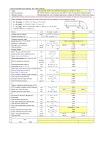Flexible ducting, also known as ‘flex’, is used to transport heated or cooled air from the unit into your home and vice versa through the grilles or diffusers. This type of duct is commonly used as branch duct in unconditioned spaces such as attics and in spaces where obstructions make the use of rigid duct difficult or impossible.
Flexible duct is not recommended for use in the return side of a system. Both metallic and nonmetallic insulated and non-insulated forms of flexible round duct are manufactured in standard duct sizes and lengths and can be easily cut to the length needed.

Sections of flexible duct can be joined using coupling sleeves. Flexible duct is fastened to metal ducts or connectors using a drawband (duct strap) and a tightening tool to fasten it . When making connections, collars, sleeves, etc. should be inserted into the flexible duct at least one inch before fastening.
For insulated duct, the insulation is fitted over the connection and fastened with a duct strap or tape. Long runs of flexible duct are not recommended. Even when properly installed, most flex duct causes at least two to four times as much resistance to airflow as the same diameter sheet metal duct. Duct runs should be kept as straight and short as possible .
Gradual bends should be used, because tight turns will greatly reduce the airflow and may even cause the duct to collapse. Flexible duct should be supported with one-inch or wider bands with a minimum of sag between the supports . Some flexible duct comes with built-in eyelet holes for hanging the duct.
If a connection to a ceiling diffuser requires a bend, it is better to use an insulated metal elbow at the input to the diffuser than to bend flexible duct to form the connection. When using flexible duct to make very short duct runs between diffusers and takeoffs on a supply duct, the vertical alignment of the flexible duct run is critical and should be plumb. If not, diffuser noise will increase and air will shoot out to one side of the diffuser rather than being distributed evenly.
How do these ductwork designs differ?
- Price :- Because metal ductwork lasts longer than flex duct, it's more costly to create, transport, and install.
- Flexibility:- Flex ducts are better for existing trunk-and-branch heating and cooling systems. This is because they're more versatile and flexible. Metal ducts are more rigid due to the nature of steel, making them ideal to build an entire HVAC system.
- Installation :- In comparison to metal duct, flex duct is easier and faster to install. Yet, this leaves more room for contractor error. Contractor error can cost you in high energy bills, excess maintenance, or sudden repairs and replacements.
- Metal duct is a pricey upfront investment for a commercial building, yet it saves money by maintaining high indoor air quality and regulating indoor temperature - no matter the outdoor climate.










-page-001.jpg)


0 Comments